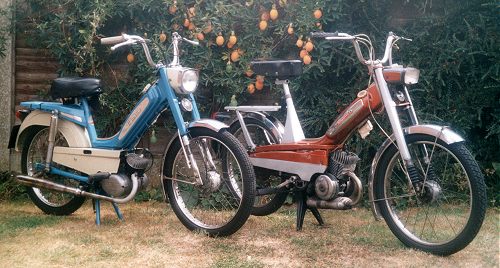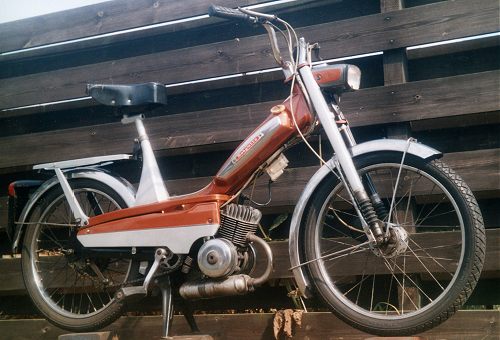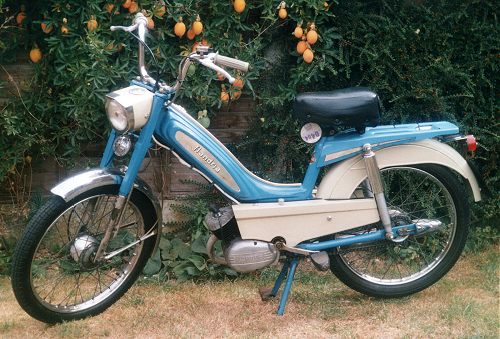 Go
to the Archive index
Go
to the Archive index"And the weather from now on will be nothing but a persistent drizzle under gloomy grey skies. Today's main course in Hotel Euroland will be the same as yesterday, and tomorrow: cold, lumpy, grey porridge. Then for dessert? More porridge, not so cold but with bigger lumps!"

Well, that should have just about set the mood for today's dainty delicacy, a god-forsaken double test of 70s Europeds. The chef appears to be dishing up a particularly stodgy pair of basic commuter mopeds on today's menu, with a seemingly flavourless Mobylette M40T Majorette from 1971, and similarly bland Flandria 147 AF-A from 1976 ... zzz ... Sorry, I must have nodded off there! Ok, let's start with the Moby.
Charles Benoit and Abel Bardin started making a cheap 172cc belt-driven 2-stroke machine in 1923, calling it Motobécane (French for motorbike). In 1925 a 308cc model was added under the Motoconfort badge, from which date various machines up to 750cc in-line fours were produced under both brands. 1949 saw the first appearance of a moped that was christened the Mobylette - it was to sell in millions and make the company known right across the world! The first AV40T was introduced into the UK from January 1970. It was followed by a multitude of unfathomably coded 40 (single-speed) and 50 (vario) versions on the same basic modular theme, square styling, cheap, mass produced, and bright gay colours (if you like that sort of thing). Our Moby test machine today however, wears a personal custom paint pattern much re-styled from the factory finish, and manages to look quite interestingly different as a result. Then, while looking round the bike a little more, you can't help noticing a few special features, like the chrome tank panels and badges that were only really fitted on the 50V model, and that rather striking cylinder head - now what's been going on there? It's a low-link 9:1 Spéciale head from an AV92, modified to match the finning pattern of the M40 barrel, and without a gasket, so this tricky machine is probably running around 10:1 compression - very sneaky, things are looking better already! On the stand, usual procedure, but when it starts - this doesn't sound anything like the stifled shopper the factory put out. There's a very noticeable punch as it fires, then rev up and that exhaust snarls back at you. Not a particularly loud note - just sharp, and really classy. With its 12mm Gurtner carb, the standard power rating was given as 2bhp, but this machine will obviously be a little higher than that.

The 1971 Mobylette M40T Majorette
Claeys-Flandria had been a bicycle maker in Zedelgem, Belgium since 1896, commencing moped manufacture in 1951 and claiming a staggering 25,000 made in the first year! Light motor cycles and scooters were added to the range up to 1957 when the company decided to concentrate solely on mopeds, going on to export them across the globe during the 1960s and 70s. Glass's index lists: "Flandria 147AF-A first imported in May 19 74, telescopic forks, swingarm rear suspension, single speed, auto clutch, 7pt fuel tank, 3" brakes, optional single or dual seat, standard colour blue", and that seems to be pretty much what we've got. At a glance the Flandria could easily be mistaken for a period Moby since the styling is very similar, but look again, and subtle differences are revealed. Motobécane didn't offer rear suspension on their single-speed models, so that's a big feature for starters. There's a nice chrome torpedo silencer on the Flandria, while the Moby merely has a painted bean-can underneath. The Flandria side-panels are finished on top by rubber trims, which many may be puzzled to discover have a functional intention. It became popular practice on the continent to ride mopeds 'scooter style' with feet off the pedals, resting inboard on the frame instead. Many riders may have noticed similar trims on their own commuter-peds. Several makers employed the feature, Mobylette, Batavus, Garelli, Vespa, and even Honda. Maybe not a riding practice adopted in Britain, but it's out there! The main difference with the Flandria to the Moby is no flailing belts and whirling pulleys, it has a unit engine with polished aluminium side casings, cast iron barrel and 7.8:1 compression aluminium cylinder head (no power rating is given). The 12mm Encarwi carb doesn't fix to the cylinder however, but bolts onto the crankcase behind it, so the engine is equipped with disc-valve induction - which is rather nice! This machine has a home made shutter strangler fitted to close the air filter, presumably to assist starting, though the machine never originally seemed to incorporate any choke or flood when made. Now you come to the greatest puzzle, how to actually start it? If you pedal away, it simply functions like a bicycle! Push it along and it just freewheels. No levers, no switches, nothing - totally baffling! Until you go to back pedal - and only then the engine turns over! The intention with the Flandria is to use either pedal as if it's a kick starter, alternatively pedal it up the road then back-pedal as you continue to coast, when the engine starts and takes over. Certainly a novelty!

The 1976 Flandria 147AF-A
The automatic clutch is probably unique in being a centrifugally operated pressure plate that engages quite readily at low revs, so the engine has to labour up to speed, though can be very capably assisted by the high geared pedal ratio if required. The disc valve intake provides excellent torque to assist low speed pull, but really you can't help wondering if the Flandria engineers had ever seen a hill in their lives since the inevitable aspect about these geological features, is that having gone up, you have to come back down again. Not really an issue on any normal machine, but the Flandria was probably only designed for the flat lowlands of Belgium and Holland. It's the way that clutch functions you see, shut down the throttle and the clutch instantly disengages the motor so you find yourself hurtling downhill at tickover in neutral! It's quite a surprise to experience, and a good job the brakes are so effective! The same obviously occurs when shutting down on the flat, though gravity has a lesser effect under such circumstances, but it's as well to keep in mind when approaching junctions.
And as the products of two European neighbours face each other across their border, eyes down and place your bets, please, in a test of the M40 Special's super high compression against the Flandria's disc valve. Acceleration: well it's a very close call as both machines are evenly matched up to 10 - 15mph, when the Flandria's torque takes it slightly ahead, but not for long as the Moby starts to close the gap again by 25mph and surges strongly away beyond 30. Hill climb: results in a dead heat on the steep incline, though the Flandria creeps a very narrow margin on the long shallow climb. Top speed (downhill, crouched): the Flandria's VDO speedo needle swings hopefully up to indicate 42mph, while the pace bike records reality as 34mph. In this domain the Moby rules supreme, registering 50mph on its excitingly optimistic Huret fib-o-meter, while the pace bike clocks this actual at 37mph. Stopping: goes very firmly to the Flandria, those brakes really are most impressive for a commuter moped (mind you, they need to be with that 'freewheel' clutch arrangement!). The feeble little Moby drums are not even in the same league.
In conclusion: this particular M40 is a great 'riders machine', the eager motor does go exceptionally well, pulls strongly, revs freely and sounds great, but a standard model just couldn't be compared with this special. Performance seems to come at a cost though, the vibrations are fierce and fatiguing, and the rigid tail gives a hard ride - you wouldn't want to do much distance on this machine. The Flandria is a most remarkable surprise! It features full suspension for a smoother ride with no vibration and good handling, yet with its 16" wheels, is conveniently small and light enough to just drop straight in the hatchback of a Ford Escort! The brakes are exemplary, while the disc-valve intake results in very useful torque. It is actually a most capable all-rounder, and once you've acclimatised to its somewhat odd features, they'll still continue to be a point of interest to your riding colleagues. Having a low-fixed seat height, it does however seem a rather small machine, and may not be particularly suited to taller riders.
Motobécane found their moped market slipping away into the 1980s, increasingly unable to compete with their outdated traditional design. In 1984 the name was changed to MBK, but to no avail, and the business shortly became acquired by Yamaha. The MBK brand still continues to trade today with a successful and popular range of modern scooters.
Flandria products were only briefly seen in the UK, imports ceased in April 1976. The company went bankrupt in 1981, and vanished without trace.
Leaving Europe, our ship sets sail to finally bring us back across the Channel, but the night is dark and a fierce storm blows us off course. Our boat founders, and as dawn breaks, we find ourselves washed up on a strange shore! Wandering inland through green valleys, we come across pit workings surrounded by great slag heaps. The year is 1950 and it can only mean one thing: Enter the Dragon!
First published, October 2003